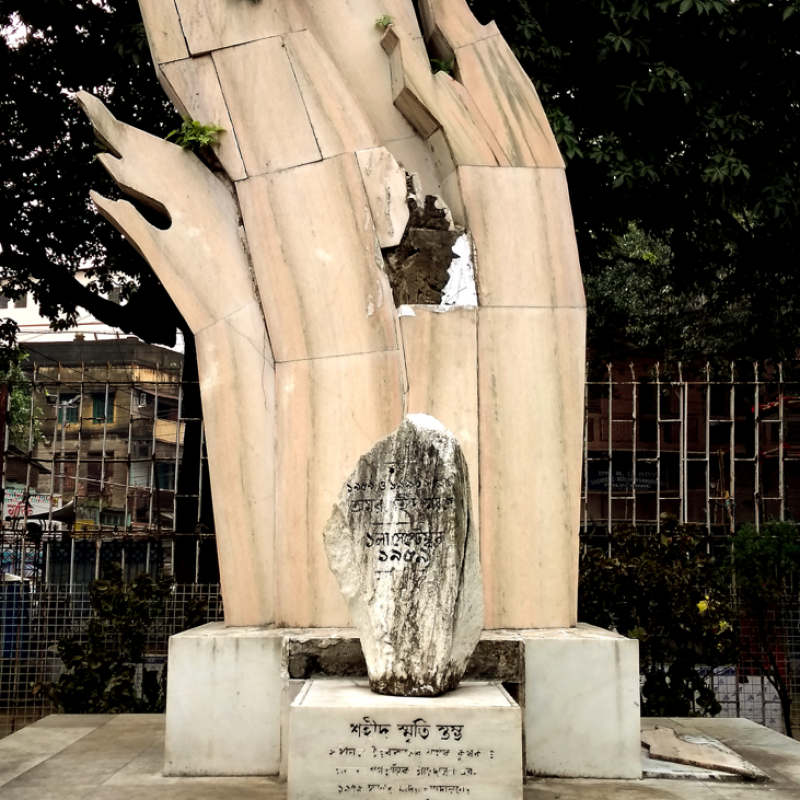Kolkata (formerly Calcutta) has witnessed a few turbulent decades after Independence. Deeply affected by India’s Partition, it received millions of refugees in the 1950s, 1960s and early 1970s. The refugee crisis coincided with a series of mass upheavals, with a cross-section of the city’s population taking to the streets, demanding adequate food, affordable public transport, fair wages, accommodation and peasants’ rights. Students, refugees, the urban middle class and labourers came together, braving the police, to participate in these movements led by various shades of Left parties.
These movements have given Kolkata a distinct character, making it synonymous with protest rallies, strikes and street corners. The city is seen as politically vibrant and these movements, from the 1950s to 1970s, have been integral in shaping this image.
A Brief Overview of the Political Movements of Calcutta: 1947–77
The year 2017 marked the 70th year of Partition, an event that was central in shaping postcolonial Calcutta in many ways. By 1951, according to the census data, Calcutta had 4,33,000 Bengali Hindu refugees coming from East Pakistan, and their numbers continued to increase over the years.[1] The presence of a large number of refugees in Calcutta transformed the politics of the city fundamentally. Therefore, any discussion of the political movements of early postcolonial Calcutta needs to begin with them.
The refugees started to organise themselves since 1948, culminating in the formation of the Communist Party-dominated United Central Refugee Council (UCRC) in 1950. Simultaneously, the Revolutionary Socialist Party (RSP), another Left political organisation, also began to mobilise the refugees under the banner of the Refugee Central Rehabilitation Council (RCRC). Throughout the 1950s, Calcutta witnessed regular rallies, meetings and hunger strikes by the refugees under the leadership of the UCRC and the RCRC. The first, and perhaps most formidable, refugee movement was in 1951 against the ‘Eviction of Persons in Unauthorized Occupation of Land Bill’ (more commonly known as the Eviction Bill). The Bill was drafted to deal with the refugees who were occupying private and public land in the city to settle down. The refugees, threatened by it, rallied behind UCRC (and RCRC in some colonies), with demands like the withdrawal of the bill, recognition of the colonies and voting rights for them. From March 1951 onwards, the rallies, meetings and public demonstrations became a part of the everyday urban life, forcing the government to considerably amend the original bill. This was the beginning of the large-scale refugee movement in Calcutta.
Refugees, under the leadership of UCRC, remained politically active throughout the 1950s and 1960s. After rallying against the notorious Eviction Bill, the refugees once again took to the streets when the government introduced the policy of dispersal—of sending the refugees away from Calcutta to less populated areas within and outside West Bengal. UCRC resisted this initiative, particularly when the refugees were sent outside the province. The condition of the refugee camps and colonies in these regions and the apathy of the local governments towards them turned most of the refugees against this proposed action.
Refugees participated in other urban protests as well. For instance, the month-long movement against the increase of the second-class tram fare by 1 paisa (July 1953) witnessed massive presence of refugee youths. Etched in the public memory as the ‘war for a pice’ (ek poishar lorai), the tram movement turned the city into a battleground. While agitators threw bombs and brickbats at trams, set them on fire, uprooted tracks, organised rallies and called for frequent strikes, the government tried to control the movement with brute force. More than 4,000 arrests were made. A few agitators died in confrontation and several were injured. Apart from the refugees, the participation of a very large number of high school and college students as well as workers, and the overwhelming sympathy of the urban middle class, made the movement a remarkable success. In the end, the Calcutta Tramways Company (CTC) was forced to reintroduce the old fare.
The following year (1954) witnessed a 10-day secondary teachers’ movement, demanding increased salaries and dearness allowance. Thousands of teachers, under the Left-led All Bengal Teachers’ Association (ABTA), struck work and began a sit-in protest near the residence of the governor. The strike ended with a violent confrontation between the city police and the protesters, killing at least five people and injuring many. The teachers’ strike was powerful enough to force the government to accept their demands.
These movements, apart from bringing immediate relief to the affected people, also brought together various Left-leaning political parties opposing the Congress government. The refugee movement, the tram movement and the teachers’ movement were important moments in the making of the Communist Party-led united Left opposition in West Bengal.
The 1950s ended with the food movement when people marched against the government in demand for adequate food at affordable prices. A crop failure coupled with a faulty public distribution system (PDS) caused the crisis of 1959. A near-famine situation hit Bengal’s villages. Peasants, in search of food, left the countryside for cities. From the beginning of 1959, Calcutta witnessed rallies and huge meetings calling for food, organised by the Price Increase and Famine Resistance Committee (PIFRC). Formed in late 1958, and dominated by the Communist Party of India, PIFRC was a platform that had representatives from almost all the Left-leaning opposition parties. The movement reached its height on August 31, 1959, when Calcutta witnessed an enormous rally where between 1,00,000 and 3,00,000 people participated. From then on, the entire city, from Maidan to Shobhabazar and Bhowanipore to Dumdum, became a scene of destruction. Students, refugees, peasants, workers and teachers under the leadership of PIFRC were at the forefront of the movement. As Prafulla Chakrabarty wrote, ‘The united Left was now in a position to mobilize the encapsulated refugees and the petty bourgeoisie at a moment’s notice; it could also rely upon the majority of the working class to respond favourably to a strike call. But what was new in the autumn of 1959 was the presence in Calcutta and its immediate neighbourhood of thousand peasants who could be thrown into the struggle.’[2]
Once again, the government tried to combat it with its police. The movement’s intensity in the city can be understood from the sheer number of deaths that occurred during this period. Between 39 to 80 people died in police firing. At least 200 protesters were missing. Many eminent personalities also came forward in support of the movement and against the police. Triguna Sen, Vice Chancellor of Jadavpur University, raised a black flag (on September 6, 1959) on behalf of his colleagues and students in protest against the government’s policies and atrocities. Martyr columns were erected overnight in different parts of the city during the movement itself. Moreover, the foundation for a permanent one was laid at Subodh Mullick Square in central Calcutta (a more elaborate structure was built here when the Left Front came to power in 1977). (Fig. 1) PIFRC also urged people to display the photographs of the martyrs in Durga puja pandals. Even today, martyr columns and plaques of this movement are easy to locate, particularly in south and central Calcutta. While the refugee movement, the tram movement and the teachers’ movement built the initial foundations of a Left political culture in the state, the food movement of 1959 cemented it.
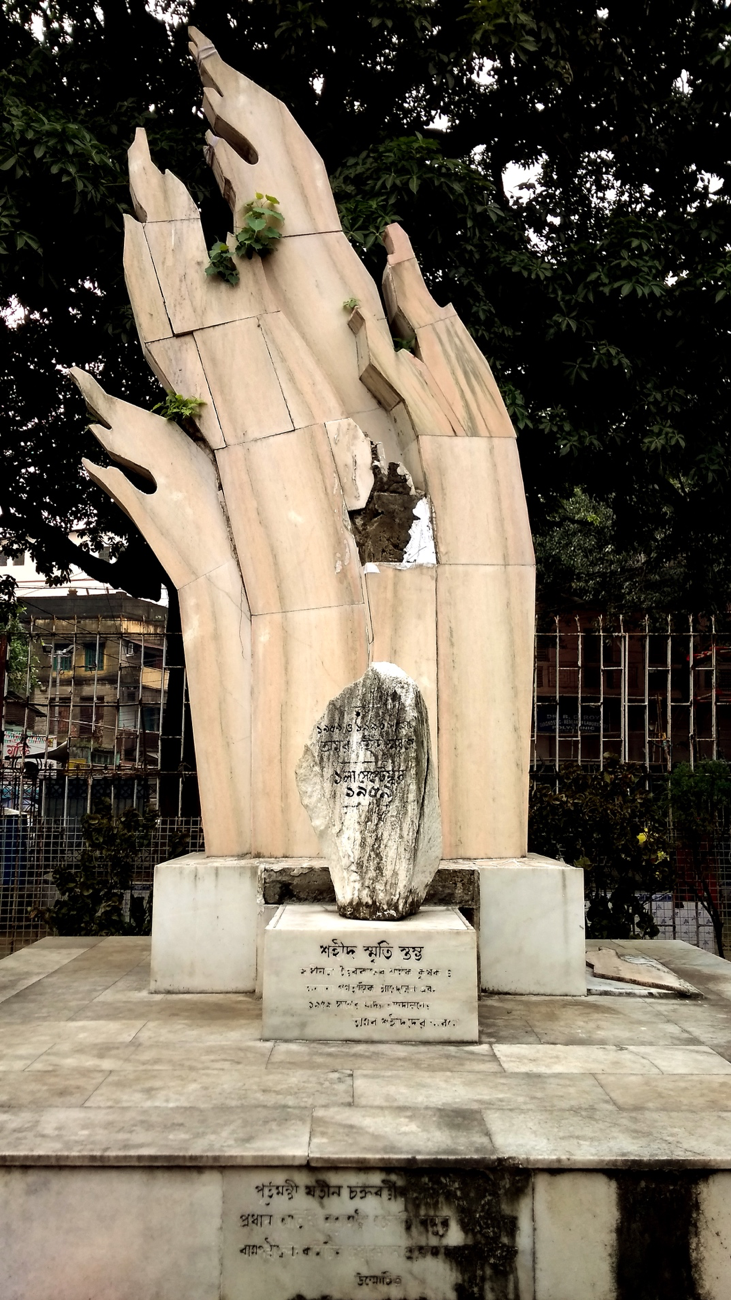
Described as a ‘turning point’ in the history of West Bengal[3], the 1959 movement officially continued till September 26. But the food crisis was far from over. West Bengal would warm up to another food movement in 1966, which would be more violent and more spontaneous in nature. A split in the Communist Party of India on ideological grounds (1964) and the formation of the Communist Party of India (Marxist) would add to the complexity of the situation.
The food movement of 1966 originated from Basirhat (24 Parganas), where the police opened fire on students who were staging a protest against the scarcity of ration and kerosene. A school student, Nurul Islam, was killed in this confrontation (February 17, 1966), and this acted as a trigger for a state-wide food movement. (Fig. 2) From Bashirhat it spread across southern Bengal and engulfed Calcutta. More violent and widespread, this movement had major consequences for Bengal politics. Continuing for about one and a half months, it witnessed exceptionally high participation from young boys, especially from the refugee colonies of south Calcutta. College Street also became a war zone, where students organised massive resistance against the police force. The turbulence reached north Calcutta as well. The local boys in the Shyambazar-Bagbazar area participated in the movement and put up fierce fights against the police and the military.[4] The city intellectuals, the Calcutta film world, various important theatre personalities and many other prominent members of the civil society came out in support of the movement and raised funds for the martyrs. Senior Congress leaders like Ajoy Mukherjee left the party to form the Bangla Congress, which supported the Left Front in the 1967 election. The defeat of the Congress government in the 1967 election was directly connected to food scarcity, sloppy PDS and the highhanded attitude of the government towards the protesters during the 1966 movement. Moreover, this movement set the context for the more violent and far-reaching Naxalite movement, which would begin the very next year.
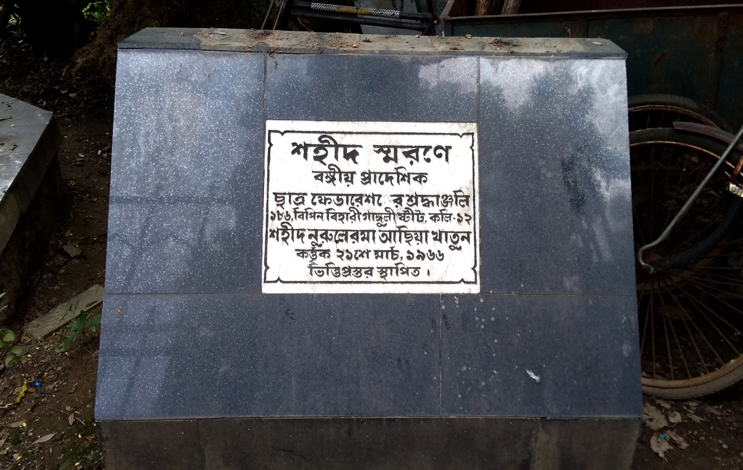
The Naxalite movement started in the summer of 1967 in northern Bengal and within a couple of years it spread across the entire province. A confrontation between the peasants and the landlords, followed by a clash between the peasants and the police, turned into a radical political movement that would dictate the politics of West Bengal for almost an entire decade. Led by the charismatic leader Charu Mazumdar—a dedicated follower of Mao Zedong—it was immensely popular among the peasants of Bengal. Mazumdar and his comrades believed in armed struggle as a means of revolution. They believed that the revolution would start from the villages and the peasants would be the main protagonists. They encouraged and inspired hundreds of the city’s students to join the peasant upsurge. Students from Presidency College, Maulana Azad College, Scottish Church College, Calcutta University, Jadavpur University, Calcutta Medical College, R.G. Kar Medical College and other important institutions left their studies and moved to the remote villages of Bengal to work with the peasants.
Though the villages were to be the epicentres of the Naxalite movement, Calcutta soon emerged as a major site of Naxalite activities. Naxal presence was particularly strong in neighbourhoods such as Shyambazar, South Sinthi-Tobin Road, East Sinthi, Kashipur-Baranagar, Dumdum, Taltala, Entally Beleghata, College Street, Shobhabazar, Jadavpur, Tollugunj, Kashba, Behala, etc. Naxalites turned Calcutta into a virtual battlefield.[5] Naxal students targeted the ‘bourgeois education system’, questioned the glory of the Bengal Renaissance and the Indian nationalist movements, and attacked the representatives of the state they wanted to overturn. Statues were demolished, examinations were stalled, and police and government employees were killed. The police, on the other hand, unleashed a rule of terror. Many Naxal activists and sympathisers were cold-bloodedly killed in fake encounters on the streets of Calcutta. The brutal killings of the city’s youth are still remembered and mourned over by the radicals and many ordinary residents.
One such killing happened in Bhawani Dutta Lane, near the Presidency University. Local people and Naxal sympathisers put up a plaque in memory of those who were killed in this police action. It is still there, though on most days it is hidden behind a fruit cart. But the locals know about it and the reasons for putting it up. The fruit vendor whose cart is usually in front of the plaque told us about the fateful night when the ‘students were killed by the police’. He is barely in his late twenties. He must have heard about the incident from the elders of the locality. The memory of the Naxal days remains strong in some quarters. College Street, not surprisingly, is one such place.[6] (Fig. 3)
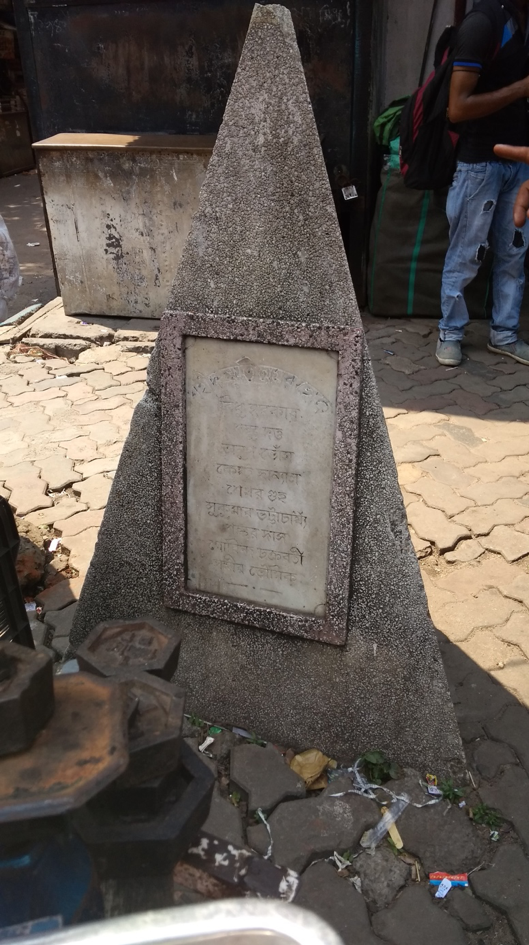
This was a period that witnessed intense violence between different political parties. The Naxals were not killed only by the police and armed forces. In many areas within and outside Calcutta, the CPI(M) and Congress party members were also involved in attacks. The Naxals themselves targeted members of Congress, CPI, CPI(M) and other parliamentary parties. One of the most senior leaders of the state, Hemanta Basu (Forward Block), was assassinated in Calcutta, allegedly by the Naxals. (Fig. 4)
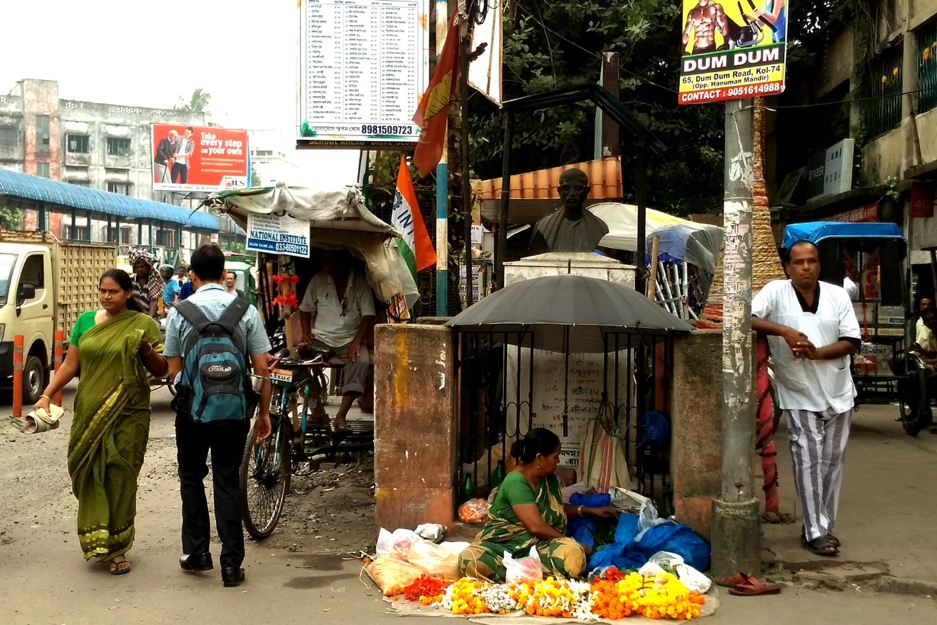
Some of these killings were in the name of ideology, some for survival and others were to take revenge. The city also witnessed several clashes between the Congress and the CPI(M) youths.
It was a strange decade for the city and the state, marked by intense violence all around. When the Left Front came to power in 1977, several martyr columns were constructed in different parts of the city to commemorate the deaths of their supporters during the Naxal period. The refugee colonies of Calcutta have some such columns. In Netaji Nagar Colony, beside the colony office and behind a shiny statue of a refugee family, is a column dedicated to six colony residents who were murdered by ‘Congress anti-socials and CRPF’. (Fig. 5) In the nearby Jadabgarh Colony is a plaque, almost illegible, dedicated to the memory of Jiten Roy, a local Congress leader, killed by Naxals in the 1970s. Two relatively new plaques stand on either side of Jiten Roy. One is in the honour of the Nandigram martyrs and the other is a ubiquitous plaque dedicated to the martyrs in general. Indeed, these three plaques jostling with each other in a narrow strip of land reminds us how all the political parties require ‘martyrs’ for writing their celebratory autobiographies.
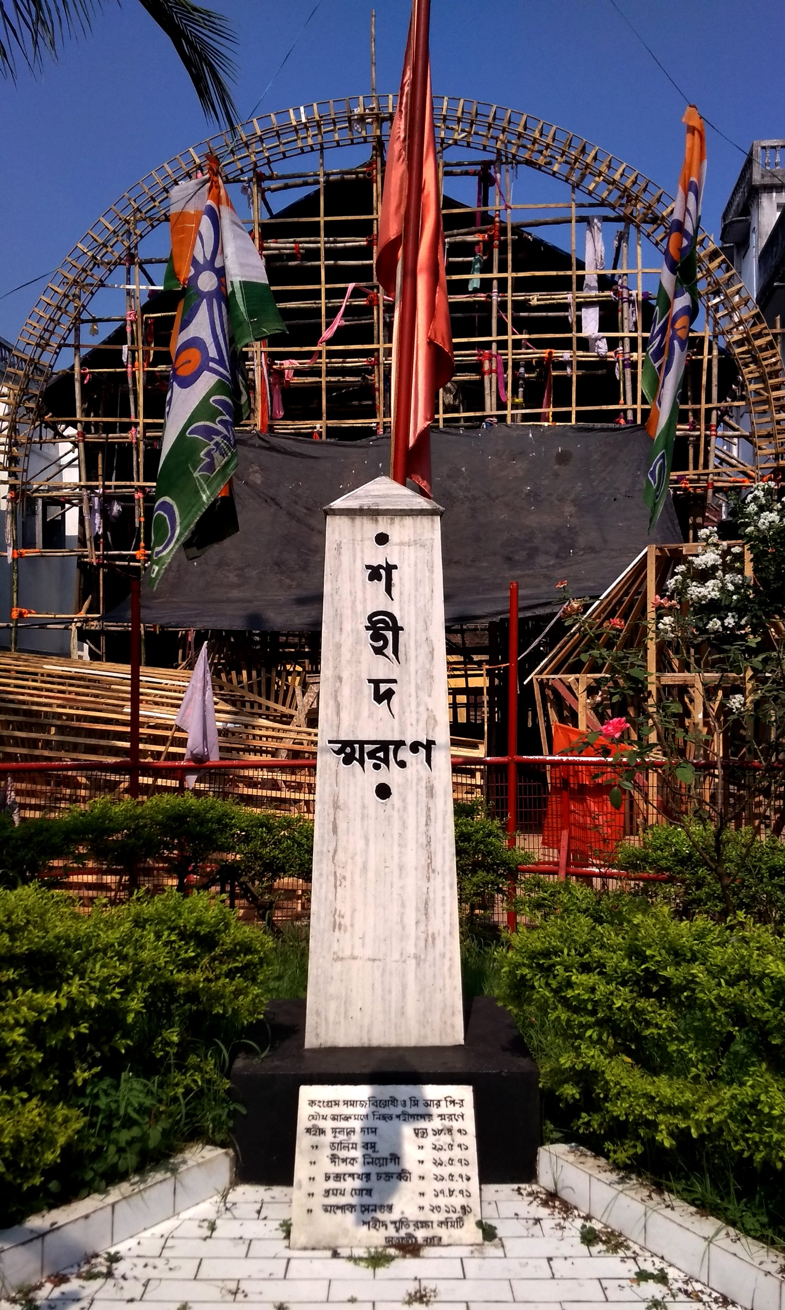
The Calcutta streets, teeming with plaques, can be confusing even to the regular passers-by. Adjacent to Netaji Nagar Colony is Naskarpara, where a martyr column that marks the death of Bimal Ghosh, killed by ‘Congressi goondas’, stands right next to a column for the martyrs of 1959 food movement. (Fig. 6) A local resident told us confidently that the killers of ‘Bimal da’ were not from the Congress but the ‘Naxal Party’.
Such confusions are not surprising. From the beginning of the 1970s, as violence escalated, it often became difficult to say who was on which side, who was a party worker and who was an informer.

Despite all-pervasive violence, the Naxalite movement generated a sincere hope among a section of people about the possibility of rapid revolutionary change in the nature of the state. The popular Naxalite slogan of 'shottor er doshok muktir doshok' (the decade of seventies is the decade of liberation) sums up the decade of activism for them.
But, the 1970s was also a decade marked by increased factionalism among the Naxalites, brutal state oppression, a surge of nationalism among the Bengali middle class around the Bangladesh War of Liberation (1971), and, finally, the declaration of Emergency by Indira Gandhi. All these factors together caused the decline of the Naxalite movement. When the first election was held after the Emergency, the Left Front, under the leadership of the CPI(M), came to power in West Bengal. With them the long insurrectional phase of politics in Calcutta came to a halt, at least for the time being.
Why Calcutta? How Calcutta?
Why did Calcutta emerge as the epicentre of insurrectional politics after 1947? To answer this question, we need to return to the Partition of India and the refugees who entered the city as a result. Because of the religious basis of Partition, Hindu refugees who entered India made a moral claim to the resources of the country and a right to rehabilitation here. But they faced an apathetic government in West Bengal.[7] The failure of the government to provide the refugees with adequate relief and proper rehabilitation, and its attempts to derecognise their right to the city through the Eviction Bill and the dispersal policy, infuriated them. As a result, Calcutta had a huge disgruntled and volatile population ready to march against an unsympathetic government. Consequently, ‘refugee clusters’ were seen as ‘dangerous and combustible concentrations’ that were difficult to govern and easy to instigate.[8] Their restless presence in the city made Calcutta an ‘insurrectional city’ after Independence.[9]
Calcutta, however, was not the only place with high refugee concentration. Census figures of 1951 show that 24 Parganas (a district in West Bengal) had more refugees and Nadia had almost as many.[10] Nonetheless, it was Calcutta, and not the two district towns, that remained the epicentre of all political movements. The reasons were obvious. A popular movement in Calcutta was bound to draw the immediate attention of the provincial government and the media. Further, if a movement could disrupt urban life or generate public sympathy, it had more chance of being effective in squeezing benefits from the authorities. Also, staging a movement in Calcutta—the seat of provincial power—had certain symbolic value, which a small town or a village would never have. Equally important were the features of the city itself. The city-space and various urban infrastructures of Calcutta aided the popular movements of early postcolonial years in multiple ways. The narrow lanes and by-lanes (galis) of the city, close-knit neighbourhoods (known as paras), and houses with little gaps in between turned it into an ideal stage for riots and rebellions.
Historian Swati Chattopadhyay highlighted in an article how Calcutta with its ‘distinct localities and intimate sociality, closely built shops and houses, where one could move from house to house, from rooftop to rooftop without stepping onto the street’[11] was ideal for street protests, mass agitations and popular insurrections. (Fig. 7) During the swadeshi movement in Bengal in the beginning of twentieth century, Chattopadhyay noted, ‘The interstices of the urban fabric and the found spaces between buildings…provided advantageous arena for tactical manoeuvre…’ to the local protesters and obstructed the entry of the police and outsiders.[12] As a consequence of this movement, the imperial capital was transferred from Calcutta to Delhi (1911)—rather to ‘New’ Delhi—which, as Chattopadhyay showed, was more ‘visually explicit’ or had more ‘spatial legibility’, and hence was easier to govern.
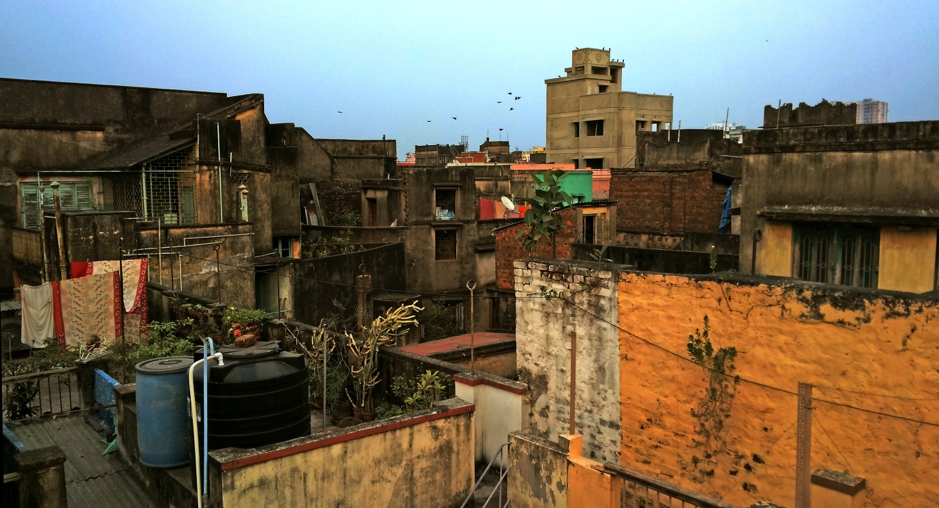
The opacity of Calcutta’s paras and galis and the closely built houses aided insurrections in early postcolonial years as well. They provided refuge during mass agitations to the ‘insiders’ from the ‘outsiders’. Those who knew the terrain would know the places to hide and the routes to escape, something police or military would not know. A team of journalists reporting on the tram movement of 1953 experienced this insideo–utside divide in South Calcutta. They were visiting the areas around Purna Cinema and Elgin Road in the middle of a night when the tram movement was at its peak, and were repeatedly stopped by the locals who let go of them only after being convinced that they were journalists:
We could see the tramlines burning a little ahead of us. We switched on the headlight of our car, but immediately the crowd shouted and hurled stones on us. We turned off the light. We could feel the presence of a huge crowd. Some of them were making mashals. A group came to us with two young men at front. We shouted: "We are from press"...then they allowed us to enter.[13]
Once they were allowed to enter the para, two young men from the locality acted as their guides. They removed tree trunks and boulders from the way so that the car could proceed. The boulders and tea trunks had made the neighbourhood even more invincible to the ‘outsiders’. As the reporters entered the para they could see how the entire local community had come together to participate in this movement:
We could see boys, young people and also elderly people among the crowd. We saw that some of them were busy uprooting the tramlines. Some middle aged men were supervising them... They showed that they were carrying fire crackers and acid bulbs...They were from middle-class educated families. We could see women standing at the terrace of the buildings by the roadside.[14]
What made a para a cohesive political unit during a mass movement was that it had fairly clear spatial boundaries. The people knew where their area began and where it ended. This well-marked boundary of a para gave a clear sense of who was from there and who was an outsider. The reporters were given a tour by the locals and then they were showed the way out:
We reached the Suburban School. In front of us, there was the wide empty main road. Across the road we could spot several police vans. Our guides told us that their area ended at that point and police’s area began from the other side of the road. The in-between area was ‘no man’s land’. They took us a little further and then shouted at the police, saying, ‘Comrades, they are reporters.’ Then they disappeared in the dark while shouting, ‘Now they are your responsibility’.[15]
These excerpts reveal how a neighbourhood had come together in support of the movement, how it had very clear boundaries, how the para-people kept an eye on (and at times controlled) who was coming and who was leaving. I have heard from my mother, who as a child had spent some years at Ballygunge Place (in south Calcutta) during the heyday of the Naxalite movement, how the women who stayed in the houses near the end of the road used to blow conch shells if and when they could see police. This was a signal for the Naxal activists of that para. Hearing it, they would flee to safer areas, often by jumping from one rooftop to another. As long as a para was together, it was like a fort. Thus, such paras, galis and the narrow gaps between houses made the city, especially certain localities within the city, suitable for insurrections. (Fig. 8)
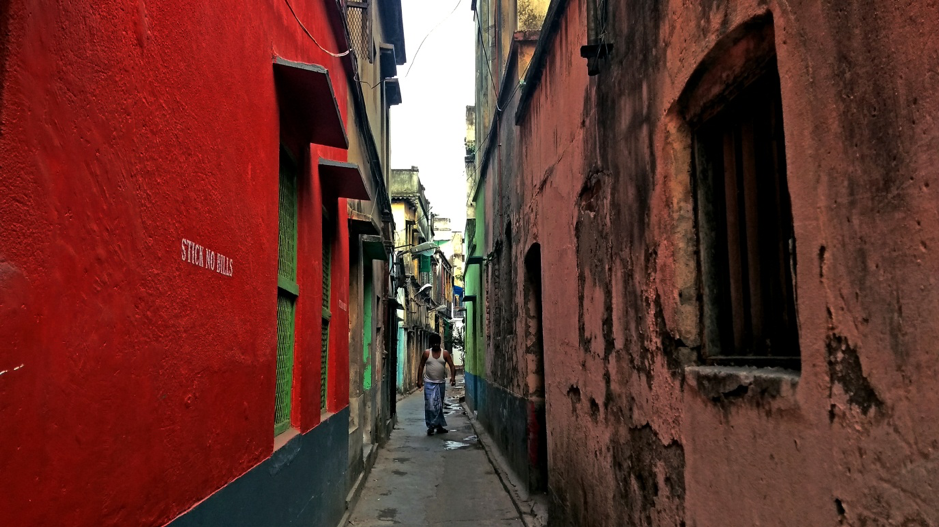
One may mention here that the refugee squatter colonies were similar to the paras for many reasons—they had clear territorial boundaries and a homogeneous population. But because of their experiences of Partition and displacement, the colony people were angrier, desperate and more willing to agitate against the government—both with their own demands and also for the other have-nots of the city. During the tram movement of 1953, as one scholar mentioned, ‘Colonies and the bustees occupied by the refugees became centres for manufactures of bombs and crackers...participation of the refugees [in the tram movement] was total.’[16] These colonies, like paras, had something opaque about them. What went on inside these neighbourhoods was only visible to someone who belonged there. As a close-knit community, the residents of the refugee colonies knew each other by face and hence could easily identify an outsider. All these made the refugee colonies suitable sites for mobilising support and providing shelters. Not surprisingly, therefore, these colonies remained strong bastions of various shades of Left politics between the 1950s and 1970s.
Apart from galis, paras and closely built houses, Calcutta had trams and tramlines that made it conducive to crowd actions. British Marxist historian Eric Hobsbawm, in his famous article ‘Cities and Insurrections’, pointed out:
…[T]ramways . . . are unusually convenient for rioters; . . . these large and track-bound vehicles, when burned or overturned, can block streets and disrupt traffic very easily. Buses do not seem to have played anything like as important a part in riots, underground railways appear to be entirely irrelevant to them (except for transporting rioters) and automobiles can at best be used as improvised road blocks or barricades.[17]
Anyone who had lived in the Calcutta of the 1950s and 1960s would have agreed wholeheartedly with Hobsbawm. Burning down the tram cars, uprooting the tramlines or throwing bombs and brickbats at the trams were most common sights of every urban protest in the city. For instance, when, in March 1948, the Communist Party of India (CPI) was banned by the West Bengal Government, the very next day ‘attempts were made by group of men to stop the tram services’ and ‘in some areas overhead tram wires were cut. Armed police patrols were guarding the tram routes.’[18] In January 1949, when the police fired at a students’ procession, the angry students attacked the trams.[19] On April 27, 1949, during a confrontation between the police and a procession led by Communist workers and members of the Mahila Atmaraksha Samiti[20], three tram cars were set on fire. On January 26, 1950, two tramcars were set on fire by the Communists after an ‘anti-republic day’ meeting in South Calcutta.[21]
The tram tracks became major targets of popular protests during the tram movement of 1953. According to the estimates of the Calcutta Tram Company, within the first six days at least 60 trams were damaged and they incurred a loss of Rs 2.5 lakh. The final days of the teachers’ movement in 1954 also witnessed similar attacks on the vehicles. During the food movement as well, trams were targeted by the protesters. Similar scenes haunted the city throughout the 1960s. Buses were also targeted and burnt down. But trams, more important mode of transport at that point, were under greater attacks. Tramlines were far more widespread at that point than they are today. Therefore, to participate in a movement, one did not have to travel across the city. One could throw a brickbat to a tram and run back to the safety of one’s own para. This also meant that a movement could spread across the city and did not have to be centred at a particular area. Since the tramlines passed through densely populated areas of the city and they were the main transport for a vast section of the urban population, any commotion around them had huge impact on urban life.
What made the tramcars and the tracks more vulnerable was their proximity to schools, colleges and universities across Calcutta. Presidency College, Calcutta Medical College, Calcutta University (all adjacent to College Street, central Calcutta), Asutosh College (near Hazra, south Calcutta), Surendra Nath College (Sealdah), Maulana Azad College (central Calcutta), etc., were all situated next to tramlines or very close to them. Students could come out of these institutions, throw a few bombs to a passing tram and run back to their colleges. As Myron Weiner wrote, while describing the tram movement of 1953, 'Students hid in colleges on the main thoroughfares of Calcutta, making barricades in the street and stoning tramcars and police. The police drove the students into the college buildings where they continued to throw stones while police remained outside the college compound.'[22]
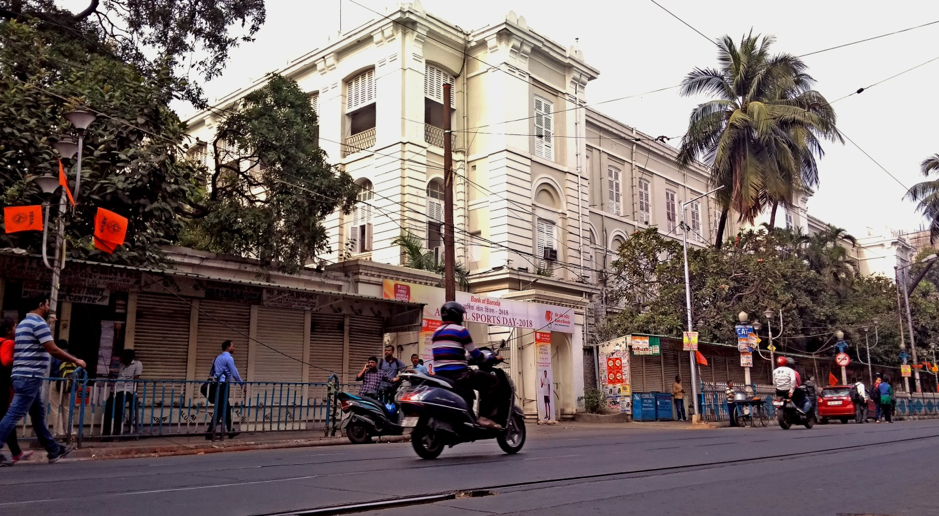
Police would often hesitate, though not always, to enter the premises of an educational institute. In most cases, they would also require permission from the head of the institute. Thus, colleges and universities, like neighbourhoods, provided relatively safe spaces for taking refuge as well as for launching attacks.
The hope and chaos of the 1950s and 1970s exists in the city’s political lore, and often comes up in literature, films, Left intellectual circles and certain political spheres. The physical imprints, on the other hand, dwindle every day in neglect and oblivion. In this scenario, academic research becomes even more important. It must function as a bridge linking the memories and built spaces of Calcutta, which were as much participants in the movements as they were stages.
Notes
[1] Chatterji, The Spoils of Partition, 119.
[2] Chakrabarty, The Marginal Men, 357.
[3] Suranjan Das and P. Bandyopadhyay edited a compiled collection of documents on the 1959 movement where they described it as a ‘turning point’ in the history of West Bengal. Das and Bandyopadhyay, eds., Food movement of 1959: Documenting a turning point in the history of West Bengal.
[4] Sengupta, Joar Bhatae Shat Sattor, 88.
[5] Bhattacharya, Karasmriti: Sattorer Mashal, 19.
[6] Few more plaques and memorial columns dedicated to Naxal activists can be found in other parts of the city as well, where the Naxal presence was strong or encounters had happened—Baranagar (north Calcutta), Ramlal Bazar (south Calcutta) and S.N. Banerjee Road (central Calcutta).
[7] Chatterji, ‘Rights or charity? Government and refugees: the debate over relief and rehabilitation in West Bengal, 1947-1950.’
[8] Chatterji, ‘‘Dispersal’ and the Failure of Rehabilitation: Refugee Camp-dwellers and Squatters in West Bengal,’ 1006.
[9] A term used by historian Hobsbawm in ‘Cities and Insurrections’.
[10] Chatterji, Spoils, 119.
[11] Chattopadhyay, ‘Cities of Power and Protest: Spatial Legibility and the Colonial State in Early Twentieth Century India.’
[12] ibid., 50.
[13] Jugantar, ‘Shukrobaareo Kolikatae Golojoj.’
[14] ibid.
[15] ibid.
[16] Chakrabarty, The Marginal Men, 344.
[17] Hobsbawm, ‘Cities and Insurrections,’ 3.
[18] The Times of India, ‘Meetings Banned in Calcutta: Armed Police Guard Tram Routes.’
[19] The Times of India, ‘Troops Called to Aid Police: Calcutta Situation under Control.’
[20] Founded in 1942, Mahila Atmaraksha Samiti was a women’s organisation in Bengal which worked closely with the Communist Party of India. It was formed to protect women from war, mobilise them against fascism and communalism, resist famine in Bengal, and empower women in other possible ways.
[21] The Times of India, ‘Bomb Incident in Calcutta: “Red” Sponsored demonstration.’
Bibliography
Bhattacharya, Amit. Karasmriti: Sattorer Mashal. Kolkata: Setu, 2014.
Chakrabarti, Prafulla K. The Marginal Men: The Refugees and the Left Political Syndrome in West Bengal. Kalyani: Lumiere, 1990.
Chatterji, Joya. ‘‘Dispersal’ and the Failure of Rehabilitation: Refugee Camp-dwellers and Squatters in West Bengal.’ Modern Asian Studies 41, no. 05 (2007): 995–1032.
———. ‘Rights or Charity? Government and Refugees: The Debate over Relief and Rehabilitation in West Bengal, 1947–1950.’ Edited by Suvir Kaul. In The Partition of Memory: The Afterlife of Division of India, 74–112. Ranikhet: Permanent Black, 2001.
———. The Spoils of Partition: Bengal and India, 1947–1967. Cambridge: Cambridge University Press, 2007.
Chattopadhyay, Swati. ‘Cities of Power and Protest: Spatial Legibility and the Colonial State in Early Twentieth-century India.’ International Journal of Urban Sciences 19, no. 1 (2015): 40–52.
Das, Suranjan, and P.K. Bandyopadhyay. Food Movement of 1959: Documenting a Turning Point in the History of West Bengal. Kolkata: K.P. Bagchi, 2004.
Hobsbawm, Eric. ‘Cities and Insurrections.’ Global Urban Development Magazine 1, no. 1 (May 2005): 1–8. Sengupta, Amalendu. Joar Bhatae Shat Sattor. Kolkata: Pearl, 1997.
Jugantar, ‘Shukrobaareo Kolikatae Golojoj’ [Troubles in Calcutta even on Friday], Jugantar, Calcutta, July 18, 1953.
The Times of India, ‘Meetings Banned in Calcutta: Armed Police Guard Tram Routes,’ The Times of India, Bombay, March 28, 1948.
———, ‘Bomb Incident in Calcutta: “Red” Sponsored demonstration,’ The Times of India, Bombay, January 28, 1950.
———, ‘Troops Called to Aid Police: Calcutta Situation under Control,’ The Times of India, Bombay, January 21, 1949.
Weiner, Myron. ‘Violence and Politics in Calcutta.’ The Journal of Asian Studies 20, no. 3 (1961): 275–81.
